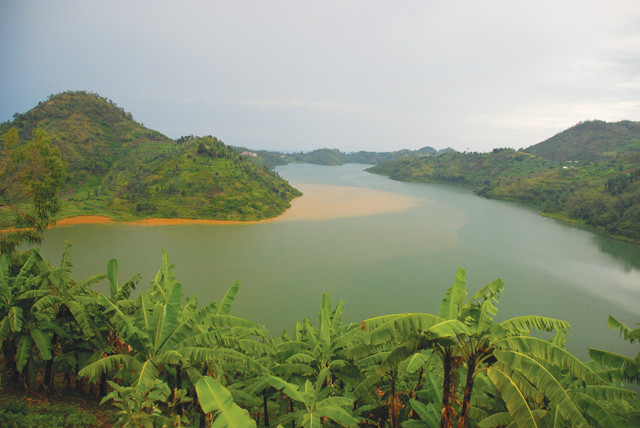
by Sara E. Pratt Wednesday, September 2, 2015

A turbid sediment plume in Lake Kivu in East Africa following a rainfall event. The discovery of ancient megaturbidites in the lake that had been instigated by floods revealed a new trigger for degassing the "killer lake." Credit: Christopher Scholz.
The deep, cold waters of Lake Kivu — a stratified volcanic lake in the East African Rift Valley on the border of Rwanda and the Democratic Republic of the Congo — hold 300 cubic kilometers of carbon dioxide gas and 60 cubic kilometers of methane, which seep from magmatic sources below the lake. An overturning of the thermally stratified waters could release those deadly gases onto a population of nearly 2 million.
Catastrophic lake degassing events can be triggered by thermal changes in the lake, or by seismic or volcanic activity — nearby Mount Nyiragongo is one of the most active volcanoes in Africa. Such events, known as limnic eruptions, have occurred at other African “killer lakes,” prompting efforts to vent Kivu’s gases before it too erupts. Now, researchers plumbing Kivu’s depths have discovered another potential trigger for limnic eruptions: underwater sediment flows induced by massive floods.
The discovery on the bottom of Lake Kivu of about 40 megaturbidites — massive, high-density sediment flows — that occurred over the past 12,000 years during very wet climate intervals was reported in Geology.
“Our data suggest that some extreme turbidity flows may have triggered mixing of the lake in the past,” says lead author Xuewei Zhang, now a geophysicist at Geo-Jade Petroleum in China who conducted the research as a doctoral student at Syracuse University.
Zhang and his colleagues discovered the previously unknown turbidites in the lake’s eastern basin while surveying the bottom for optimal sites to drill cores to reconstruct past records of overturn. The researchers used radar and seismic reflection profiling to produce high-resolution acoustic images of the lake-bottom structure and stratigraphy.
Twelve thousand years ago, the water level in the lake was about 380 meters lower. At that time, the turbidite channels were river valleys, which, as lake levels rose, later flooded and became conduits for the turbidity flows.
The team also collected sediment cores, which they radiocarbon dated and compared to paleohydrologic records — including water-level records of tropical East African lakes and hydrogen isotope ratios from leaf waxes found in ancient lake sediments, which are a proxy for humidity. This revealed that the climate was unusually wet at the time the turbidite sequences were deposited, which occurred on average once every 300 years.
“These extraordinary events coincide with wet periods in the climatic history of the region, and more importantly they also appear to be related to deep mixing in the lake,” says George Kling, a biogeochemist at the University of Michigan who was not involved in the research. This is “very interesting research, and the science seems sound,” Kling adds.
In the sediment cores, Zhang and his team also found the remains of massive algal blooms associated with the turbidites, which suggest the density-flows disturbed the stratification and overturned the lake, bringing nutrient-rich bottom waters to the surface.
“This evidence for deep mixing provides the connection between flood events and hazardous gas releases from the lake — if nutrients are being mixed up to the surface, then so are the dissolved gases stored in bottom waters,” Kling says.
The thicknesses of the turbidite layers range from 0.1 centimeters to more than 100 centimeters, which indicates that the size of the floods that emplaced them varied to a large extent as well. The single largest event deposited 40 million cubic meters of sediment.
“We can’t predict when such an extreme flood will occur in future, but it will happen,” Zhang says. “Considering the presence of the large amount of carbon dioxide and methane in the lake, we want to be aware and further evaluate potential gas-release risks associated with exceptional floods.”
“We don’t know how much energy it would take from a flood to trigger a giant gas release,” Kling adds, “and, hopefully, we’ll never find out.”
The findings also have implications for the ongoing engineering efforts to degas the lake, which involve sinking pipes deep into the lake to release the pressurized gas. “For the deployment of the gas-extraction facilities,” Zhang says, “it is advisable to avoid these paleo-river valleys, which are preferential turbidity flow pathways.”
© 2008-2021. All rights reserved. Any copying, redistribution or retransmission of any of the contents of this service without the expressed written permission of the American Geosciences Institute is expressly prohibited. Click here for all copyright requests.